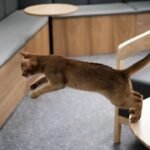Have you ever wondered how your feline friend communicates their need for comfort without uttering a single meow? Cats, with their mysterious and enchanting ways, have a unique manner of expressing themselves that often goes unnoticed. They are masters of silent communication, using subtle gestures and behaviors to convey their emotions. For cat lovers, understanding these silent signals can deepen the bond with their furry companions. Let’s delve into the fascinating world of feline communication and explore the ten ways cats silently say, “I need comfort.”
Seeking Warmth: Curling Up in Cozy Spots
Cats have an innate love for warmth, and when they seek comfort, they often curl up in the coziest spots they can find. You might find them nestled on a sunlit windowsill, snuggled up in a soft blanket, or even resting on your lap. This behavior is not just about physical warmth; it provides a sense of security and emotional comfort. When a cat curls up, it’s akin to wrapping themselves in a comforting hug, reminding them of the safety they felt as kittens.
Slow Blinks: The Subtle Sign of Trust
If you’ve ever caught your cat giving you a slow, deliberate blink, consider yourself lucky. This is a profound sign of trust and affection. In the feline world, a slow blink is the equivalent of a warm smile or a gentle hug. Cats use this gesture to communicate that they feel safe and comfortable in your presence. Returning the slow blink is a wonderful way to reassure your cat that they are loved and secure.
Purring: The Gentle Vibrations of Contentment
Purring is perhaps the most well-known way cats express comfort. The gentle, rhythmic vibrations are not just a sign of contentment but also a self-soothing mechanism for cats. When they purr, they are often seeking comfort, especially when they are feeling stressed or anxious. It’s their way of calming themselves and signaling to you that they need a little extra love and attention.
Nuzzling: The Sweet Gesture of Affection
When a cat nuzzles against you, it’s a heartwarming display of affection and trust. This behavior is rooted in their kittenhood, where they would nuzzle against their mother for warmth and comfort. By rubbing their face against you, they are marking you with their scent, claiming you as part of their safe space. It’s their silent way of saying, “You are my comfort.”
Following You: The Silent Shadow
Ever noticed your cat trailing behind you as you move from room to room? This behavior is more than just curiosity; it’s a sign that they seek comfort in your presence. Cats are known for their independence, but when they choose to follow you, it’s a testament to the bond you share. They find solace in your company, and your presence brings them a sense of security.
Kneading: The Rhythmic Dance of Contentment
Kneading, often referred to as “making biscuits,” is an adorable behavior where cats rhythmically push their paws against a soft surface. This action is reminiscent of the way kittens knead their mother’s belly to stimulate milk flow. In adulthood, kneading becomes a comforting ritual, a way for cats to self-soothe and express their contentment. It’s a silent plea for comfort, as they recreate the nurturing sensations of their early days.
Tail Tucking: The Protective Posture
A cat’s tail is a powerful tool for communication, and when they tuck it close to their body, it’s a sign that they are seeking comfort. This behavior often occurs when a cat is feeling vulnerable or anxious. By tucking their tail, they are minimizing exposure and protecting themselves. It’s their way of seeking reassurance and comfort from their surroundings or from you.
Head Butting: The Friendly Gesture of Trust
Head butting, or “bunting,” is a delightful way cats show affection and seek comfort. When a cat gently presses their head against you, they are marking you with their scent, reinforcing their bond with you. This behavior is a sign of trust and a request for attention and comfort. It’s their way of saying, “You are my safe haven.”
Hiding: The Silent Retreat
While it may seem counterintuitive, when a cat hides, it can be a sign that they need comfort. Cats often retreat to quiet, secluded spots when they are feeling stressed or overwhelmed. This behavior is a coping mechanism, allowing them to feel safe and secure. Providing a cozy hiding spot can offer them the comfort they seek during times of distress.
Grooming: The Calming Ritual
Grooming is not just about cleanliness for cats; it’s a soothing ritual that provides comfort. When a cat grooms themselves or even you, it’s a sign that they are seeking tranquility and reassurance. The repetitive action of grooming releases endorphins, helping them relax and feel more at ease. It’s their silent way of finding comfort in familiar routines.
Understanding these silent signals can transform your relationship with your cat, allowing you to respond to their needs more effectively. Cats are complex creatures with a rich emotional world, and recognizing their subtle cues can deepen the bond you share. Next time your feline friend exhibits one of these behaviors, take a moment to appreciate their unique way of saying, “I need comfort.” What silent signals have you noticed in your cat?

Suhail Ahmed is a passionate digital professional and nature enthusiast with over 8 years of experience in content strategy, SEO, web development, and digital operations. Alongside his freelance journey, Suhail actively contributes to nature and wildlife platforms like Feline Fam, where he channels his curiosity for the Feline into engaging, educational storytelling.
With a strong background in managing digital ecosystems — from ecommerce stores and WordPress websites to social media and automation — Suhail merges technical precision with creative insight. His content reflects a rare balance: SEO-friendly yet deeply human, data-informed yet emotionally resonant.
Driven by a love for discovery and storytelling, Suhail believes in using digital platforms to amplify causes that matter — especially those protecting Earth’s biodiversity and inspiring sustainable living. Whether he’s managing online projects or crafting wildlife content, his goal remains the same: to inform, inspire, and leave a positive digital footprint.






